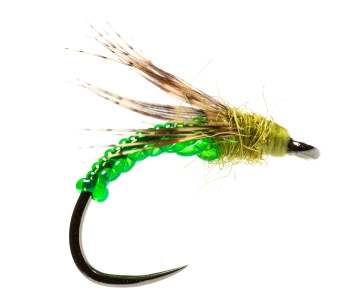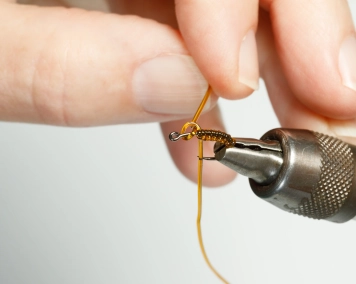Introducing a way of making nymph bodies using elastic bead cord and a knotting technique
Elastic bead cord has many potential uses in fly tying; it can be used as a rib over a dubbed body or wound up a hook in touching turns to imitate a translucent segmented body. It comes in lots of colours and is very durable. It’s also very cheap, I bought ten eight-metre spools of different colours online for less than £8 several years ago and I’ve still got loads left.
Wrapping bead cord over a base of tying thread or tinsel makes a serviceable body, but knotting it adds structure and texture which I think looks more lifelike than a simple series of coils. The examples shown here are all tied using a Genoese Bar knot, which is simply a series of alternating half hitches tied onto a bare hook. The hitches sit along the sides of the hook giving a flattened segmented profile with the dark hook showing through the transparent elastic.
Unlike weaving techniques using thread or wire, which I have tried at various times and always concluded that life is just too short to bother with, a simple repeating knot sequence is quick and easy. There’s no need to turn your vice around to face you, although it will make the process easier until you get used to it. The repeating chain of knots is easy to form and unlike complicated weaves it’s pretty difficult to lose track of where you are in the sequence. Most importantly, bead cord knots stay put when they are tightened so you can stop at any time without your work unravelling before your eyes. No more cursing if you let go or when the phone rings.
Once you’ve knotted a bead cord abdomen onto a bare hook, attached the tying thread and secured and trimmed the ends of the cord, what you stick in front to finish the fly is up to you. You can go simple, maybe just a soft hackle or some dubbing, or more complex if you have an imitation rather than an approximation in mind. The examples shown here are simple but have enough features to suggest a range of critters a hungry fish might fancy.
Nick Thomas
Tying a Genoese Bar Body
-
Tie an overhand knot around the hook with the ends underneath.
-
Slide the knot back and tighten against the vice jaws.
-
Take one end under the hook, back over the top and through the loop.
-
Pull the half hitch tight with the end under the hook.
-
Repeat with the end on the other side of the hook.
-
Pull tight against the previous half hitch.
-
Continue adding hitches to alternating sides of the hook.
-
Finish on the side opposite to the starting side.
-
Pull the ends tight ready to secure with tying thread.
Once you’ve got the hang of the technique you can speed up tying by twisting the bead cord. Instead of looping around the hook and threading through the loop just hold an end and twist it to form a loop, pass the loop over the hook eye and pull tight to form the half hitches.
Nick Thomas
- Log in to post comments
























